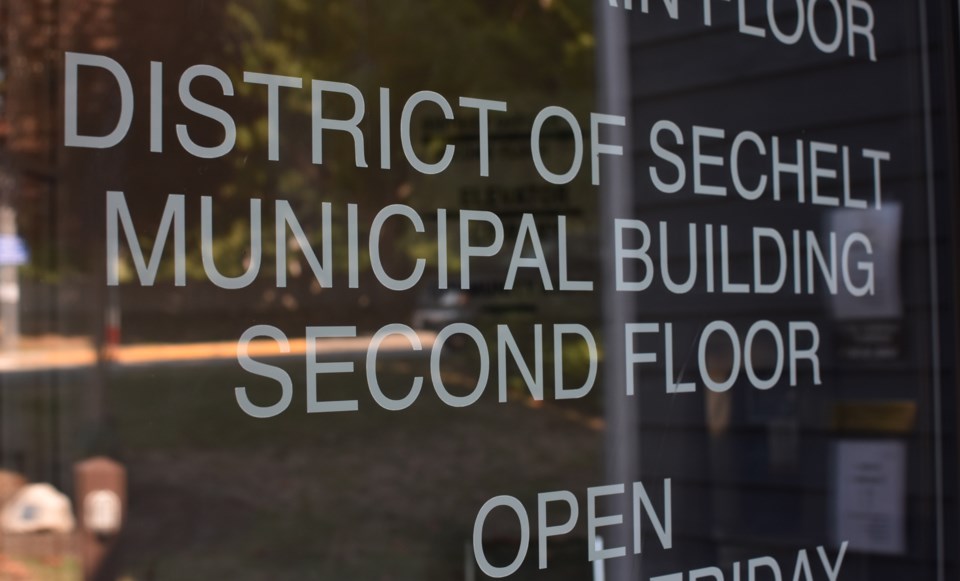Mark your calendars, Sechelt. Sept. 8 will see the public hearing for the updates proposed to establish the District of Sechelt’s Zoning Bylaw 580, which regulates all land use within the municipality.
At the July 20 council meeting, council gave second reading to the updates suggested for Bylaw 580. The changes attempt to completely review the current version of the bylaw — No. 25 from 1987 — to reexamine allowable uses, modernize regulations and simplify zones.
Council reviewed the first draft in April and gave first reading in May.
Staff reported back to council on the referral process that took place over the last few months.
‘This is a starting point’
Updating the bylaw has been more than a decade in the making, and was prioritized by council in 2019. With just a few months left in their term, council voted unanimously in favour of moving forward in the process.
Most of the council members took time to speak in favour of moving the bylaw forward. Coun. Matt McLean said the bylaw is “a good foundation that we can build off and really shape the next OCP [Official Community Plan]” following its adoption.
Coun. Alton Toth called the bylaw a good baseline. “The housing crisis cannot be swept under the rug. It can't be sort of tinkered at around the edges with the zoning update. It really is a fundamental crisis in our planning, in our everything on the Sunshine Coast right now… I think we could do more. But I'm also not willing to risk grinding to a halt to try and get more done now,” Toth said.
Siegers agreed with McLean, and noted the OCP is typically revised every 10 years or so and is currently outdated. “But in the meantime, we've been working with a zoning bylaw that is not in conformity and, in fact, in a lot of places conflicts with the Official Community Plan. That caused more work for our staff, that's caused confusion and more work for those who are looking to build in the district. So, by actually bringing this Zoning Bylaw into alignment with the official community plan, it will set us up for the work that you're talking about, Councillor Toth, Councillor McLean,” she said.
The bylaw is not a perfect document, Coun. Brenda Rowe acknowledged, but is “long overdue.”
“I think that we do have to look at what our community is now, but we also have to look into the future. The growth we're experiencing, the homelessness we're experiencing,” Coun. Janice Kuester said. “But this is a starting point and we need a starting point.”
Referral comments
Senior policy planner Sam Hogg highlighted some of the comments staff received during the 60-day referral period, which ended July 4.
The only statutory referral was to the Ministry of Transportation and Infrastructure (MOTI), the authority that must approve any zoning bylaw change that impacts properties within 800 metres of the controlled-access highway, he said. MOTI has granted provisional approval but did not provide comments, and staff will continue to report to that ministry.
Staff also sent referrals to the Ministry of Agricultural Land Commission, the Ministry of Food and Agriculture, Vancouver Coastal Health, the Sechelt Chamber of Commerce, Sechelt Downtown Business Association (SDBA), Sunshine Coast Regional Economic Development Organization (SCREDO), the Sunshine Coast Affordable Housing Society and community associations.
Staff are hoping to hear back from shíshálh Nation by the end of month, Hogg said.
Both SCREDO and the affordable housing society supported the bylaw and mentioned the district should proceed with measurements that allow higher density. Given sufficient community involvement, both were supportive of the density bonusing scheme for rental housing.
SDBA and the chamber agree with moving away from units per hectare (UPH) as a measurement, saying it encourages the development of large luxury units, and both were against the loss in height in many residential zones, instead asking for an increase in height and density in most residential zones.
“District staff support moving towards using FAR [floor area ratio] throughout Bylaw 580, although this is a change that will need to come as part of a future OCP update,” the staff report states.
VCH supports prioritization of development away from rural areas, and was supportive of the shift toward mixed-use development.
The Ministry of Agriculture and Food and the Agricultural Land Commission are supportive of the new AG1 zone for parcels that are part of the Agricultural Land Reserve. The ministry noted the district’s regulations around cannabis production were “overly restrictive” and suggested increasing the lot coverage and decreasing the setback, which staff said was “echoed” by the ALC and therefore reduced from 100 metres to 50 metres.
Minor changes will be made to the M1 zone, following feedback from the East Porpoise Bay Community Association, to allow live/work units, tourist commercial and tourist accommodation as permitted secondary uses.
Council comments
Coun. Tom Lamb proposed moving the frontline properties for the I1 zone from nine metres to five metres, (and noted that this would not affect the I1 properties he owns, which already have their development permits and setbacks set). The change, he said, would help with land use, costs, parking and storage.
Lamb’s motion was passed with Lamb, Siegers, Toth and Kuester in favour and McLean opposed. (Rowe was not present at this point in the meeting.)
Toth voiced his concern around auxiliary detached dwellings, saying residential zones with septic carrying capacity and setbacks to manage it should be allowed an detached auxiliary dwelling (although he did not make a motion).
What's next
Following the public hearing on Sept. 8 at 6 p.m., Bylaw 580 can move toward third reading and be considered for adoption. It will require statutory approval from MOTI before the bylaw can be adopted. Council has one more meeting, Aug. 3, before breaking for the rest of the month.



